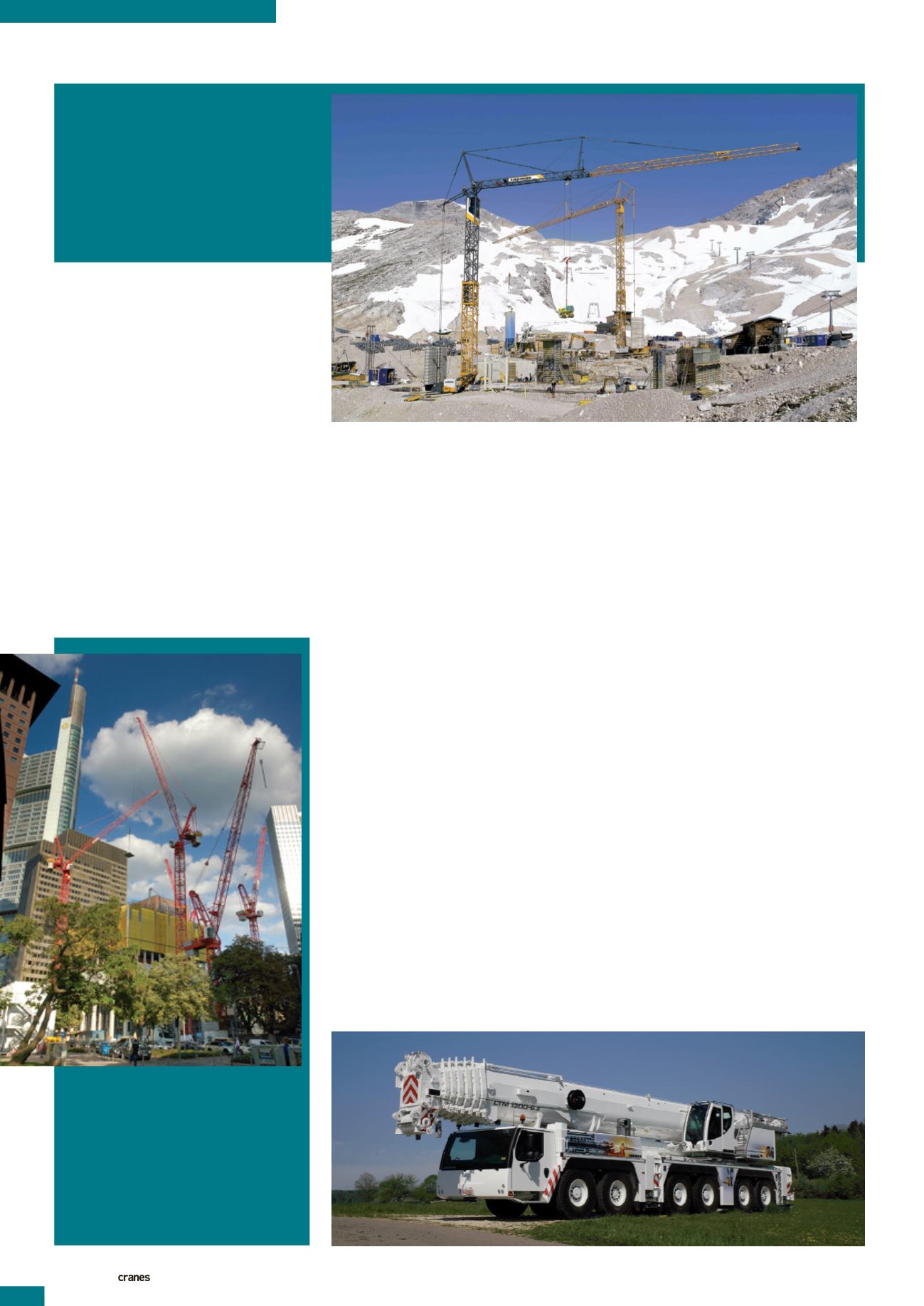
REGION FOCUS: EUROPE
INTERNATIONAL AND SPECIALIZED TRANSPORT
■
OCTOBER 2013
28
A 170 metre high-rise office building in
the financial district of Frankfurt, Germany,
has five Wolff luffing jib cranes on site. Ed.
Züblin AG is building the 170 m TaunusTurm
on Neue Mainzer Straße which will
accommodate offices, apartments and
restaurants. To maintain stability the tower
cranes are anchored to the building from a
height of 51 m upwards.
A Liebherr 65 K and a Liebherr 71 K fast
erecting tower crane at the foot of the summit
of the Zugspitze. The cranes are working at
an altitude of more than 2,000 metres above
sea level to build a new lift station and a
restaurant. The cranes were dismantled into
easy handling units for transporting on the
Zugspitze railway and then erected again at
the new lift station.
to maintain and easy to repair, a company
spokesperson explains.
A shift towards increased flexibility has
also been noted by crane manufacturers.
This is not just for heavy crawlers but
also for wheeled mobile cranes. “There
is a shift away from the 2- and 3-axle
segment towards the 4- and 5-axle segment.
With ever increasing pressure on legal
conformity while travelling to site, it
becomes ever more important that jobs can
be done with either none or less additional
counterweight that needs transporting,”
explains a Tadano spokesperson.
Construction challenges
To meet the demands of the cost-conscious
industry, new cranes aimed at the European
market are being designed to offer
increased flexibility, improved transport
features and a better return on investment.
Crane manufacturer Liebherr-Werk
Biberach, in Germany, for example, has
released five new cranes for the European
market this year. “We have developed five
new cranes for 2013, including the new
357 HC-L luffing jib crane, the new
MK 140 mobile construction crane, and
the 150 EC flat top crane. We have also
launched two new large cranes this year, the
1000 ECH and the 1000 ECB.”
The 357 HC-L luffing jib tower crane is
available in 12 to 24 tonne or 18 to 32 tonne
versions. The foundation cross base is
6 x 6 m and the hoist unit is designed for
heights of up to 1,100 m. The 150 EC flat
top is available in 6 tonne and 8 tonne
versions in a FR.tronic or Litronic
design. The 1000 ECH is available in
a 20 to 40 tonne and a 20 to 50 tonne
version. “This crane is primarily used
for dam construction, power plants,
industrial sites, bridge construction sites
and in shipbuilding yards,” a company
spokesperson says. The 1000 ECB has short
radii of 31.5 m and 36.5 m. In its 6-line
version capacity is 125 tonnes and the
4-line version lifts 100 tonnes. It is design
for hoist heights of up to 180 m.
Finally, the new MK 140 mobile
construction crane, which was a prototype
>
at Bauma, has a load capacity of 8 tonnes,
a radius of 57 m and a capacity at the tip
of 1.8 tonnes. “The jib can be moved to
a luffed position of 70 degrees and can
provide a hook height of up to 95 m,” a
company spokesperson adds.
New tower cranes from Manitowoc
include the MDT 248, which completes its
flat top tower crane range in the midsize
capacity class. Also new from Manitowoc
is the Igo M14 self erecting tower crane,
which can be transported on the road with
towing axles at up to 80 km/h. The
Igo M14 is designed for central European
and western European markets.
Smaller construction sites present a
challenge for crane manufacturers, as a
spokesperson fromWolffkran explains,
“Space in inner-city construction sites is
becoming ever more limited; so space for
the assembly of the crane, as well as its
operation, is a real issue. Cranes are also
required to lift heavier loads as a result
of the trend towards the increased
use of prefabricated elements on
construction jobs.”
The latest development fromWolffkran
to meet these demands on urban
construction sites is the Wolff 7032clear.
“The Wolff 7032clear extends our Clear
line range of Wolff flat top cranes. It is a
250 tonne-metre crane with a maximum tip
The Liebherr LTM 1300-6.2 has a single
engine and a 78 m telescopic boom


